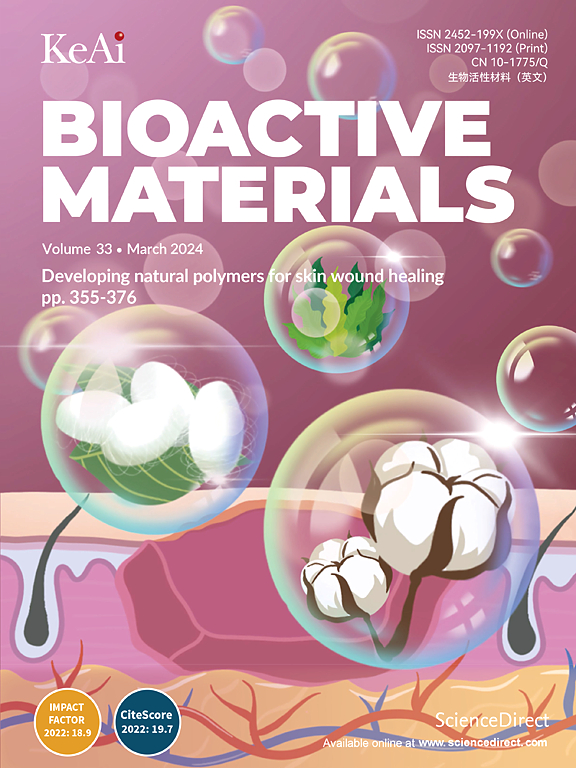Innovative liquid embolic agents based on deep eutectic solvent: Rapid gelation in situ via solvent exchange with water for endovascular embolization
IF 18
1区 医学
Q1 ENGINEERING, BIOMEDICAL
引用次数: 0
Abstract
Current liquid embolic agents face several challenges, including poor biocompatibility and vascular recanalization. Herein, we propose an innovative liquid embolic agent composed of a coenzyme-based polymer (poly lipoic acid, PLA) and a biocompatible solvent (deep eutectic solvent, DES). The agent undergoes phase transformation to form a stable hydrogel in situ through solvent exchange with water, thereby enabling safe and effective embolization. First, DES is obtained by heating a mixture of choline chloride (ChCl) and glycerol (Gly). Subsequently, lipoic acid (LA) is incorporated into the DES and heated to produce the PLA/DES complex. Owing to the strong hydrogen bonding between the DES and PLA, the DES acts as a solvent while also inhibiting PLA depolymerization. Upon contact with blood, most of the DES exchange with water, whereas some amount of ChCl integrates within the PLA via strong hydrogen bonding. This hydrogen bonding not only prevents PLA depolymerization but also reinforces the PLA network, resulting in a stable PLA hydrogel rather than depolymerized LA monomers. Furthermore, liquid-metal (LM) nanoparticles are incorporated to fabricate radiopaque PLA/LM/DES. PLA/LM/DES shows better in vitro hemocompatibility and cytocompatibility, milder inflammatory response in a rat model, and more effective and safer embolization in a rabbit model than a commercial embolic agent (Onyx). Thus, this work provides an innovative liquid embolic agent and broadens the biomedical applications of DES.

基于深度共熔溶剂的创新液体栓塞剂:通过溶剂与水交换,在原位快速凝胶化,用于血管内栓塞
目前的液体栓塞剂面临着一些挑战,包括生物相容性差和血管再通。在此,我们提出了一种创新的液体栓塞剂,由辅酶基聚合物(聚硫辛酸,PLA)和生物相容性溶剂(深共晶溶剂,DES)组成。药剂通过与水的溶剂交换,在原位发生相变形成稳定的水凝胶,从而实现安全有效的栓塞。首先,通过加热氯化胆碱(ChCl)和甘油(Gly)的混合物来获得DES。随后,硫辛酸(LA)加入到DES中并加热以产生PLA/DES复合物。由于DES与PLA之间存在较强的氢键,DES在抑制PLA解聚的同时也起到溶剂的作用。与血液接触后,大部分DES与水交换,而一定量的ChCl通过强氢键整合在PLA内。这种氢键不仅可以防止PLA解聚,还可以加强PLA网络,从而产生稳定的PLA水凝胶,而不是解聚的LA单体。此外,还加入了液态金属纳米颗粒来制备不透射线的PLA/LM/DES。PLA/LM/DES在大鼠模型中表现出更好的体外血液相容性和细胞相容性,在大鼠模型中表现出更温和的炎症反应,在兔模型中表现出比市产栓塞剂(Onyx)更有效和更安全的栓塞作用。因此,这项工作提供了一种创新的液体栓塞剂,拓宽了DES的生物医学应用。
本文章由计算机程序翻译,如有差异,请以英文原文为准。
求助全文
约1分钟内获得全文
求助全文
来源期刊

Bioactive Materials
Biochemistry, Genetics and Molecular Biology-Biotechnology
CiteScore
28.00
自引率
6.30%
发文量
436
审稿时长
20 days
期刊介绍:
Bioactive Materials is a peer-reviewed research publication that focuses on advancements in bioactive materials. The journal accepts research papers, reviews, and rapid communications in the field of next-generation biomaterials that interact with cells, tissues, and organs in various living organisms.
The primary goal of Bioactive Materials is to promote the science and engineering of biomaterials that exhibit adaptiveness to the biological environment. These materials are specifically designed to stimulate or direct appropriate cell and tissue responses or regulate interactions with microorganisms.
The journal covers a wide range of bioactive materials, including those that are engineered or designed in terms of their physical form (e.g. particulate, fiber), topology (e.g. porosity, surface roughness), or dimensions (ranging from macro to nano-scales). Contributions are sought from the following categories of bioactive materials:
Bioactive metals and alloys
Bioactive inorganics: ceramics, glasses, and carbon-based materials
Bioactive polymers and gels
Bioactive materials derived from natural sources
Bioactive composites
These materials find applications in human and veterinary medicine, such as implants, tissue engineering scaffolds, cell/drug/gene carriers, as well as imaging and sensing devices.
 求助内容:
求助内容: 应助结果提醒方式:
应助结果提醒方式:


